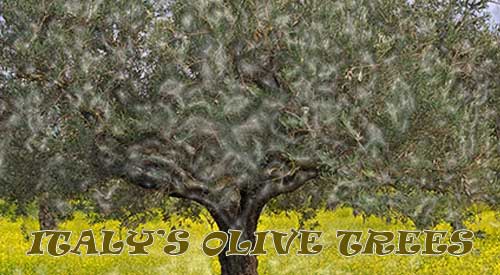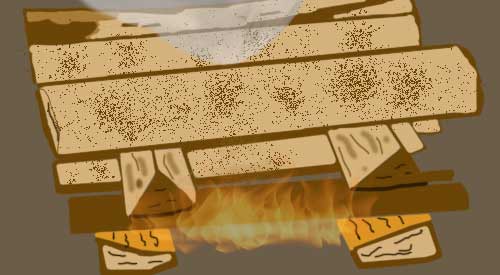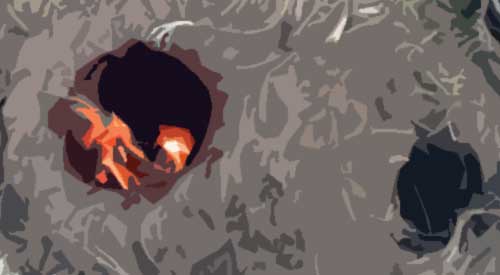 |
| Our Finished Greek Style Smoked Meatballs done on a Kettle Grill! |
Although I love Italian-style meatballs with traditional red sauce as a sandwich, I’m going to change up the flavors by making a Greek version. Then I’ll smoke my meatballs on the charcoal grill using charwood, which is a partially charred hardwood from SmokinLicious® that still retains a core of uncarbonized material to release wood flavorings.
My Greek-style meatball will feature feta cheese, oregano, and parsley, and will be finished with a Greek-yogurt cucumber sauce. I’ll swap traditional sub-style bread for a pita pocket that will make this the perfect meatball sandwich that’s lighter on the belly but not light on flavor and satisfaction
Tasting Notes: Feel free to use any type of equipment for the cooking and smoking of the meatballs. Just remember to use wood for added flavor to the finished meatball product.
It Starts with Quality Meatball Ingredients

Obviously, meatballs start with the meat. We’ll be using ground chuck for this recipe. Taking two pounds of ground chuck, I add one cup of crumbled feta cheese. To that, I add two tablespoons fresh oregano, two tablespoon fresh chopped flat leaf parsley, ½ teaspoon of crushed red pepper, 1 large beaten egg, 1 teaspoon kosher salt, and ½ teaspoon fresh ground pepper. Mix all the ingredients well until evenly combined. This recipe will make approximately 32 meatballs that are 1-inch in diameter.
Lighting the Grill
As with all our recipes, you can elect the type of equipment you want to do the actual smoking and cooking on as well as the charcoal and hardwood choices. Today, I’ll be using my Weber kettle as this is an ideal grate size for my sheet pan.
 After
mixing and forming the meatballs, I’ve placed them on a foil lined
sheet pan over direct heat.
After
mixing and forming the meatballs, I’ve placed them on a foil lined
sheet pan over direct heat. There is no need to turn these meatballs as due to their small size, they will crust all the way around on their own. In 20-30 minutes, these will have reached 160° F and be ready for eating. For the record, my intake vent is open half way and the outtake is wide open.
Tasting Notes: Keep in mind, when you use any type of metal pan with direct heat and wood product on a grill, some level of creosote will develop on the bottom of the pan. I’ve found that if I spray a small quantity of oven cleaner on these areas while the pan is still hot, in 5 minutes I can simply wipe away with a wet cloth or sponge.
Greek-Yogurt-Cucumber Sauce
When eating Italian meatball sandwiches, the sauce is traditionally red tomato. For Greeks, it is a light, tangy cucumber-Greek yogurt sauce that accompanies the meatball. Here’s our rendition of this sauce.

Start with one cucumber, peeled, seeded and grated. Be sure to squeeze the extra water from the grated cucumber so the sauce does not become watery. Add 1-1/2 cups of whole milk Greek yogurt, followed by three tablespoons fresh, chopped mint, one tablespoon fresh, chopped dill, ½ teaspoon lemon zest, one tablespoon fresh lemon juice, ½ teaspoon salt and ½ teaspoon fresh ground pepper.
Mix well and refrigerate until ready to use. This will make about 1 cup of sauce.
Make a Pita to Your Liking!
 I’m
using whole wheat pita but any blend of grain can be used. I start by
adding shredded lettuce to each pita pocket half. I prefer a bit of
moisture both at the base of the pita as well as on top of the final
ingredient. I add a tablespoon or so of the yogurt-cucumber sauce to
the shredded lettuce, then top with sliced red onion and tomato slices.
Next, in go the smoked meatballs. I prefer to slice the meatballs in
half to make eating the pita easier since each bite will be quite
substantial. After adding about three meatballs worth of meat, another
dollop of sauce goes on top and we’re ready to eat!
I’m
using whole wheat pita but any blend of grain can be used. I start by
adding shredded lettuce to each pita pocket half. I prefer a bit of
moisture both at the base of the pita as well as on top of the final
ingredient. I add a tablespoon or so of the yogurt-cucumber sauce to
the shredded lettuce, then top with sliced red onion and tomato slices.
Next, in go the smoked meatballs. I prefer to slice the meatballs in
half to make eating the pita easier since each bite will be quite
substantial. After adding about three meatballs worth of meat, another
dollop of sauce goes on top and we’re ready to eat!Obviously, this is a recipe to make your own with the type of fillings you love. That may include more spice from jalapeno or banana peppers, or more saltiness from black or green olives. Change up the lettuce leaves to kale or spinach. The options are limitless but the flavors will always be fresh and balanced.
What are your favorite pita or sandwich fillers? Leave us a comment to opine and subscribe to get all our postings on tips, techniques and recipes. Bringing innovation to wood fired cooking with recipes, techniques and the science behind the fire, smoke, and flavor. That’s SmokinLicious®.










